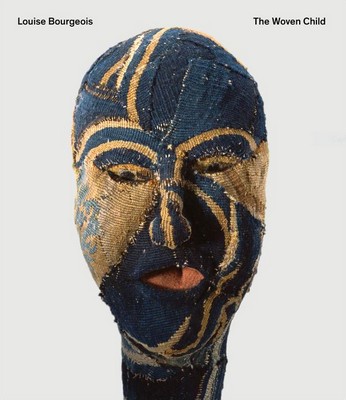Louise Bourgeois: The Woven Child
Hayward Gallery, London
Through 15 May 2022
The Hayward Gallery presents Louise Bourgeois: The Woven Child, the first major retrospective of this legendary artist to focus exclusively on the works that she made with fabrics and textiles during the final chapter of her storied career. These works, many of which have never been shown before in the UK, comprise one of the greatest late career chapters in the history of art.
The exhibition focuses on the mid-1990s until Louise Bourgeois’s death in 2010; a period during which the artist forged a body of work that re-articulated many of her lifelong concerns in newly provocative and profoundly enlivening ways, including her exploration of identity, sexuality, family relationships, reparation, and memory. In surveying this late body of work, Louise Bourgeois: The Woven Child explores what the artist, in her own words, called ‘the magic power of the needle … to repair the damage’ and to offer ‘a claim to forgiveness’.
Louise Bourgeois created an astonishingly inventive, and psychologically charged, range of sculptures using domestic textiles, including clothing, linens and tapestry fragments, often sourced from her own household and personal history. This departure from traditional sculptural materials represented a return to Louise Bourgeois’s roots; her connection to fabric began in her childhood, during which she helped in her family’s tapestry restoration atelier in France. Louise Bourgeois’s decision to create artworks from her clothes and household textiles was thus a means of transforming, as well as preserving, the past. She viewed the actions involved in fabricating these works – cutting, ripping, sewing, joining – in psychological and metaphorical terms, relating them to notions of reparation and to the trauma of separation or abandonment.
Featuring around 90 works, Louise Bourgeois: The Woven Child surveys the complete range of fabric artworks that Louise Bourgeois produced during her last two decades. The exhibition includes major installations, notably several of Louise Bourgeois’s monumental Cells, in which hanging configurations of old dresses, slips, and nightwear directly reference her personal history. The imposing installation Spider (1997), and the related Cell piece, Lady in Waiting (2003), incorporate fragments of antique tapestry. Louise Bourgeois understood the spider as both protector and predator, and associated it with her mother, a weaver and tapestry restorer. Its ability to weave a web from its own body was a metaphor that Bourgeois also used to describe her artistic process and is a particularly poignant image within this survey of her fabric work.
The exhibition includes a comprehensive range of figurative sculptures, many of which are missing limbs and heads or feature fantastical bodies that call to mind characters from unsettling fairy tales. Presented in vitrines, suspended from the ceiling, or displayed on plinths, Louise Bourgeois’s fabric figures – which largely portray female bodies – pointedly conjure states of abjection, abandonment, or entrapment. A significant selection of the artist's fabric heads are also showcased, revealing the wide range of expressions that she elaborated in these uncanny and impactful portraits. Also featured is a selection of Louise Bourgeois’s ‘progressions’: columns of stacked textile blocks or lozenges, organised in ascending and descending sequences. With these works, Louise Bourgeois returned to the vertical sculptural forms that dominated her early work in the 1940s and ‘50s, only now rendered in soft materials. Louise Bourgeois regularly revisited and revised motifs from earlier works throughout her career, a practice that reached a climax with a group of four major late works, made during the last five years of her life, in which combinations of different types of sculptures are displayed together in large vitrines. Collectively, they constitute a kind of summary statement of her late fabric art.
In addition to sculpture, the exhibition highlights a wide selection of Louise Bourgeois’s vibrant fabric drawings, books, prints and collages, including collages which feature large-scale clock faces that she produced during the final year of her life.
Philip Larratt-Smith, Curator at The Easton Foundation says: “Louise Bourgeois’s fabric work is a remarkable and unexpected final act. There is no falling off in the fertility of her imagination, no slackening of the impulses behind her astonishing range of formal invention. Taken as a whole, the fabric work is both a summing up and a recalibration of the forms, processes, motifs, and ideas that obsessed Bourgeois over a lifetime.”
Ralph Rugoff, Director at the Hayward Gallery, says: “We are thrilled to present this major retrospective of Louise Bourgeois’s rich and utterly compelling works made with textiles. While touching on many themes central to her earlier works, Louise Bourgeois’s carefully considered use of varied fabrics, including time-worn materials, imbues her late sculptures with a striking sense of intimacy, vulnerability and mortality. Over a decade after the artist’s death, these works continue to challenge us with questions that seem more compelling and urgent than ever.”
Louise Bourgeois: The Woven Child is curated by Hayward Gallery Director Ralph Rugoff, with Assistant Curator Katie Guggenheim and Curatorial Assistant Marie-Charlotte Carrier.
The exhibition will tour to Gropius Bau, Berlin from 22 July to 23 October 2022.
Published by Hayward Gallery Publishing and Hatje Cantz
Paperback (full flaps), 208 pages, 280 x 240 mm
136 colour illustrations
ISBN: 978-3-7757-5149-0
The exhibition is accompanied by a fully illustrated catalogue with newly commissioned essays by curator and scholar Lynne Cooke, novelist Rachel Cusk, curator Julienne-Franziska Lorz, and Hayward Gallery Director Ralph Rugoff.
THE HAYWARD GALLERY
Southbank Centre, Belvedere Road, London SE1 8XX



